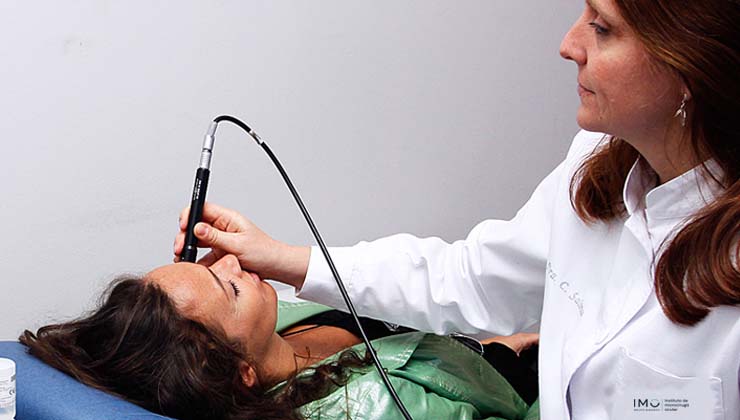
What is it?
The ocular ultrasound scan provides a view of the eye’s structures that are not accessible through other conventional tests and examinations, thanks to the ultrasound technique.
The high-frequency waves projected into the eye create reflections that form a precise image of its structure. It is also used to measure the size of the eye and to see any injuries to the structures of the eyeball.
There are two types of ocular ultrasound scan:
- B SCAN: for the retina, optic nerve and other structures of the entire eyeball.
- UBM (ultrasound biomicroscopy): for anterior segment structures (iridocorneal angles, iris, crystalline lens, lenses, ciliary processes).
How is it performed?
The test is performed with the patient half-upright or lying down, applying anaesthetic eye drops to avoid any discomfort due to the ultrasound transducer touching the eye.
It is performed with the eyes closed, although the eyes might have to be kept open on occasions.
The UBM-type ultrasound scan (anterior segment) is performed with the eye open.
It must be performed by an expert ophthalmologist in the procedure and in interpreting its results. The images are obtained in real time and in high resolution.
5 keys to the topography
- It is a painless test, but does require the application of anaesthetic eye drops.
- It is a non-invasive test for patients.
- It requires no pupil dilation.
- Contact lenses do not have to be removed for any time beforehand.
- The estimated duration is 15 minutes.
What diseases can be diagnosed?
- Condition of the back of the eye (retina) in the event of corneal opacities, dense cataracts or major haemorrhages.
- In cases of eye trauma or foreign bodies.
- To assess muscles and structures of the eyeball.
- To detect ocular tumours and post-treatment monitoring.
- To track evolution in cases of glaucoma (especially closed-angle) via UBM.
- To assess optic nerve excavation in cases of media opacification.
- To prepare for certain surgeries with lens implantation
IMO Institute of Ocular Microsurgery
Josep María Lladó, 3
08035 Barcelona
Phone: (+34) 934 000 700
E-mail: international@imo.es
See map on Google Maps
By car
GPS navigator coordinates:
41º 24’ 38” N – 02º 07’ 29” E
Exit 7 of the Ronda de Dalt (mountain side). The clinic has a car park with more than 200 parking spaces.
By bus
Autobus H2: Rotonda de Bellesguard, parada 1540
Autobus 196: Josep Maria Lladó-Bellesguard, parada 3191
Autobuses H2, 123, 196: Ronda de Dalt – Bellesguard, parada 0071
How to arrive at IMO from:
IMO Madrid
C/ Valle de Pinares Llanos, 3
28035 Madrid
Phone: (+34) 910 783 783
See map in Google Maps
Public transport
Metro Lacoma (líne 7)
Autobuses:
- Lines 49 & 64, stop “Senda del Infante”
- Line N21, stop “Metro Lacoma”
Timetables
Patient care:
Monday to Friday, 8 a.m. to 9 p.m.
IMO Andorra
Av. de les Nacions Unides, 17
AD700 Escaldes-Engordany, Andorra
Phone: (+376) 688 55 44
See map in Google Maps
IMO Manresa
C/ Carrasco i Formiguera, 33 (Baixos)
08242 – Manresa
Tel: (+34) 938 749 160
See map in Google Maps
Public transport
FGC. Line R5 & R50 direction Manresa. Station/Stop: Baixador de Manresa
Timetables
Monday to Friday, 09:00 A.M – 07:00 PM





